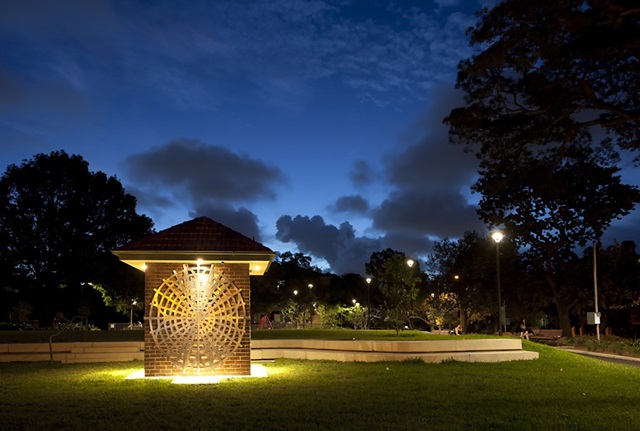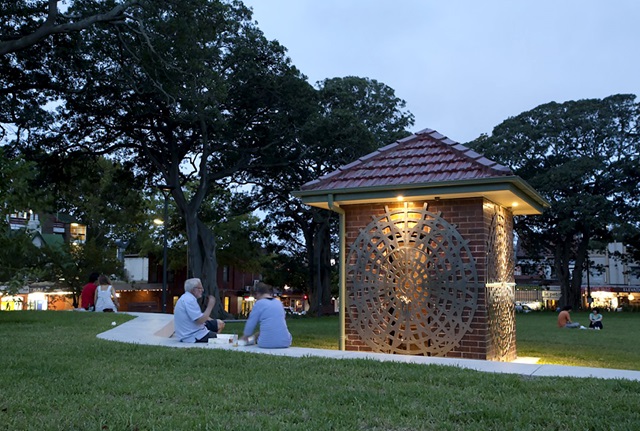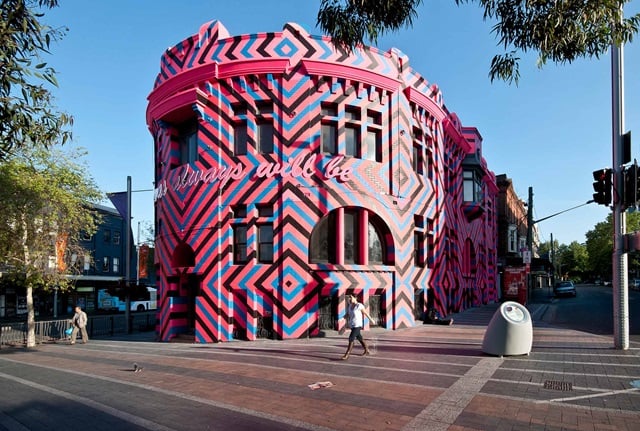


A place where people came together to listen to the wireless is brought back to life with old radio broadcasts, community and oral histories and wi-fi.
Curator: Michael Goldberg
Artwork description
Sound artist Nigel Helyer and his team from ‘Sonic Objects; Sonic Architecture’ have breathed life back into the historic Wireless House, in Foley Park.
Wireless House was a unique place for the community to enjoy listening to daily radio programs from 1934 until the early 1950s. Helyer’s concept reconnects the sonic history of the Wireless House, with oral histories from the community.
The small brick building at the intersection of Glebe Point Road and Pyrmont Bridge Road was built in 1934. A wireless set was donated at the time by the department store Grace Bros. on Broadway, so that local people who could not afford to buy radios might sit in the park and listen to the programs of the period.
The project ‘re-sounds’, or adds sound back into the structure, creating a contemporary version of its original social function. The Wireless House automatically detects visitors on approach and randomly selects audio sequences from a large database of archival and community oral history material, broadcasting them at a modest level for listeners nearby.
In a literal play on the word ‘wireless’, the site is also the City of Sydney’s first outdoor internet hotspot, providing free internet access.
Laser cut aluminium grills have been inserted on all 4 exterior sides of the building, in a visual reference to its updated function. Each grill has been designed with a different pattern, modelled on graphic representations of radiation patterns from radio antennae. The grills provide a view of the underlying structure and interior, refurbished with the extant radio stand and period crystal radio equipment.
Wireless House was launched with the opening of Foley Park on 26 September 2009. A partnership with the National Film and Sound Archive as well as a significant oral history program run by members of the Glebe community, called Glebebytes, was also established to make it a project which will be part of the social fabric of Glebe for years to come.
Wireless House by Helyer and the City of Sydney was highly commended at the National Trust of Australia Awards in 2010. The award recognised well-considered conservation work that enriches local experience through reactivated use of a significant place.
– Nigel Helyer, 2009
Artist
Dr Nigel Helyer (aka DrSonique) is an independent Anglo-Australian sculptor and sound artist. He is the director of a small multidisciplinary team ‘Sonic Objects; Sonic Architecture’ with an international reputation for large-scale sound-sculpture installations, environmental public artworks, museum interactives and new media projects.
Glebe Point Road public art program
The Glebe Point Road public art program was a result of local feedback from members of the Glebe community in June 2006 as part of our streetscape improvement program.
Local resident action and community groups proposed the project including public art, in their submission to the City of Sydney's priority projects for Glebe in 2006–2010.
We developed a staged and integrated public art program with members of the community, including workshops, a temporary community art project and permanent works, in partnership with Glebe Youth Services.
The 3 projects selected to be part of the Glebe Point Road public art program were Allan Giddy’s Earth v Sky, Nuha Saad’s Skippedy Skip and Dr Nigel Helyer’s Wireless House.









